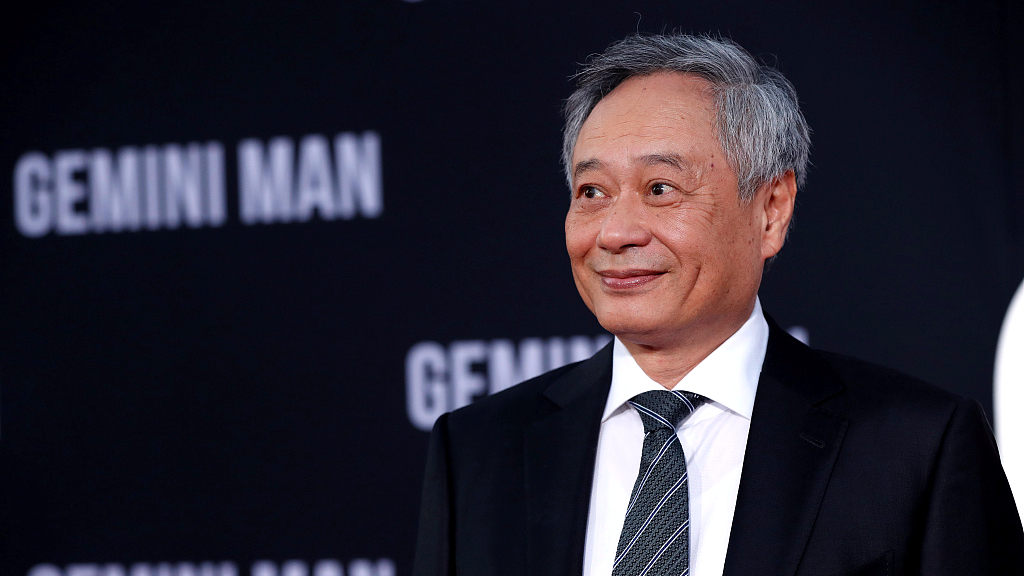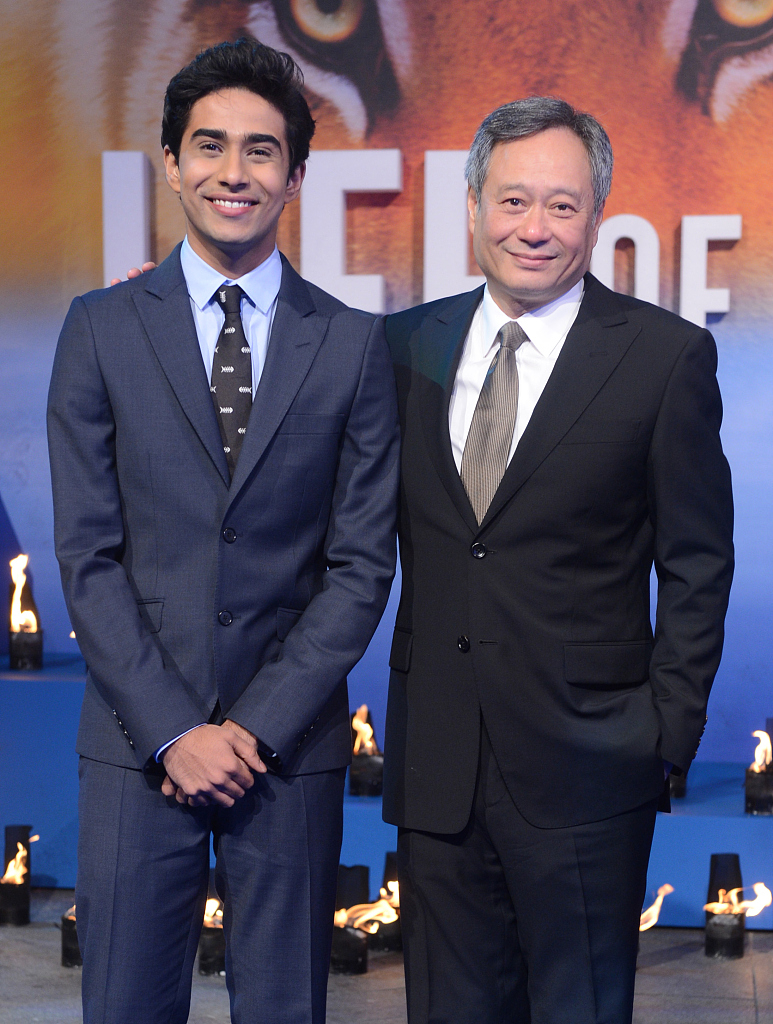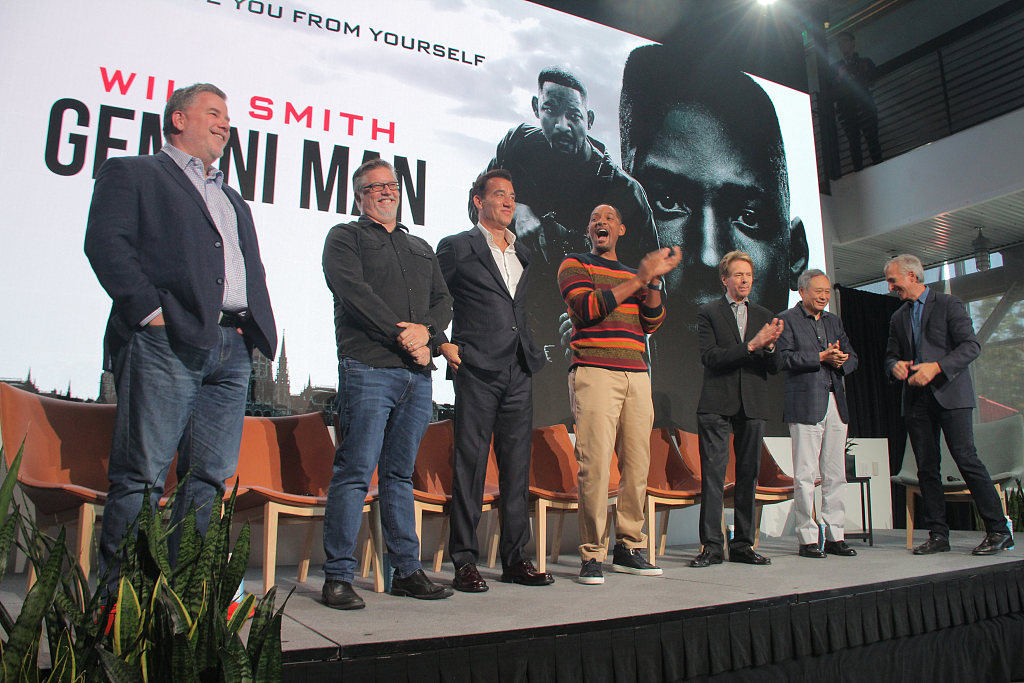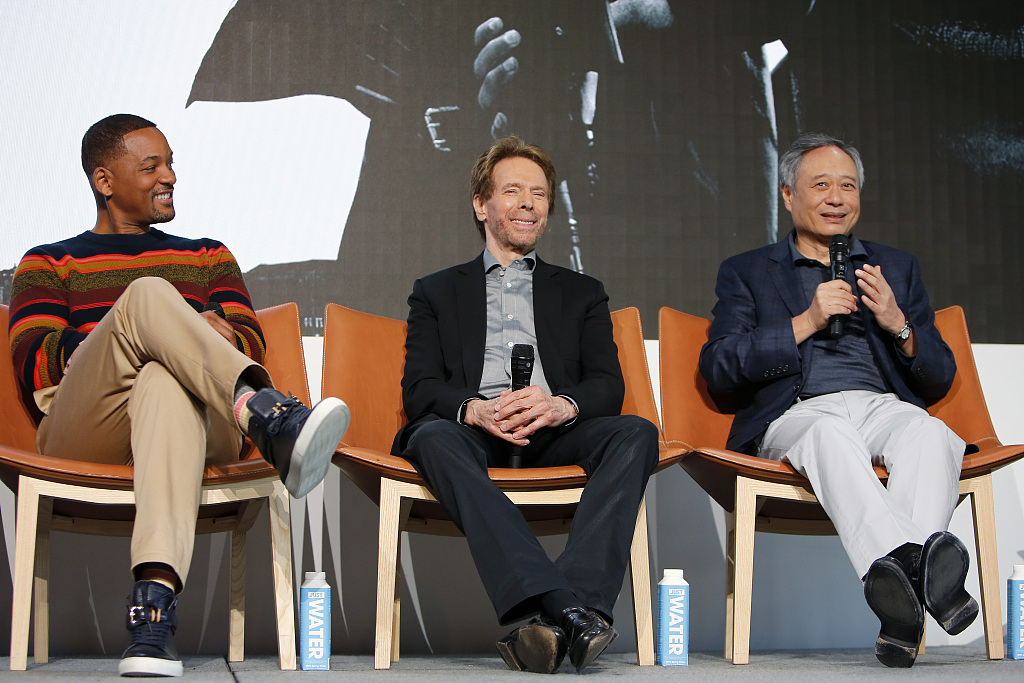
Director Ang Lee poses at the premiere of "Gemini Man" in Los Angeles, California, U.S., October 6, 2019. /VCG Photo
Director Ang Lee poses at the premiere of "Gemini Man" in Los Angeles, California, U.S., October 6, 2019. /VCG Photo
Ang Lee's conversion began with "Life of Pi."
It was the director's first movie in 3-D, and he sweated anxiously over the implementation of the technology and the torturous process of adapting Yann Martel's fanciful and allegorical book set principally in a raft containing a 450-pound Bengal tiger.
Lee was excited, though, to challenge himself with, as he says, a new dimension. But an early trial — a test shot with a dancing Indian girl — was disappointing.
"I realized I couldn't see anything. I couldn't see her expression. There was so much jitter. I thought something was wrong with the camera," recalls Lee. "I sort of freaked out. But I couldn't back out. That started my journey."

Suraj Sharma (L) and Ang Lee attend the premiere of "Life Of Pi" at Empire, Leicester Square in London, UK. /VCG Photo
Suraj Sharma (L) and Ang Lee attend the premiere of "Life Of Pi" at Empire, Leicester Square in London, UK. /VCG Photo
That journey has turned into one of the more unexpected and drastic left-hand turns of any filmmaker as highly regarded as Lee is. The director has long been a moving target, leaping from his native Taiwan ("The Wedding Banquet") to Jane Austen's England ("Sense and Sensibility") to Rick Moody's Connecticut ("The Ice Storm") to Chinese wuxia ("Crouching Tiger, Hidden Dragon") to the Wyoming mountains ("Brokeback Mountain").
But "Life of Pi" began a new quest for Lee.
Since that 2012 film, a global smash with 609 million U.S. dollars in ticket sales, Lee has dedicated himself to uncovering what he calls the aesthetics of 3-D and digital cinema. Those technologies, he believes, aren't minor new iterations to moviemaking but, if fully grasped, are a new medium entirely. Lee has, at 64, completely remade himself as a filmmaker. He's not even sure that term — "filmmaker" — is quite right anymore.
"A lot of things we never ask. Why 24 frames? Where does that number come from? I began to question my faith, the religion I have, which is movies," says Lee. "I went through a lot of mental crises."

(L-R) Guy Williams, Bill Westenhofer, Clive Owen, Will Smith, Jerry Bruckheimer, Ang Lee are pictured at "Gemini Man" Press Conference at the YouTube Space LA on October 4, 2019 in Los Angeles, California, U.S. /VCG Photo
(L-R) Guy Williams, Bill Westenhofer, Clive Owen, Will Smith, Jerry Bruckheimer, Ang Lee are pictured at "Gemini Man" Press Conference at the YouTube Space LA on October 4, 2019 in Los Angeles, California, U.S. /VCG Photo
This weekend, Lee will release into theaters the latest result of his newfound digital faith, "Gemini Man." It stars Will Smith as a government assassin who discovers his former mentor cloned him. Smith is pursued by a younger version of himself (a digital character crafted through motion-capture).
Like Lee's previous film, the Iraq War veteran tale "Billy Lynn's Long Halftime Walk," ″Gemini Man" was made with a frame rate of 120 frames-per-second and in 3-D.
And like "Billy Lynn," the response from critics has been brutal. Reviewers have criticized the film's uninspired story line but critics' primary contention is with the high-frame rate, or HFR. Lee isn't the only one to push the format. His HFR comrades include Peter Jackson and James Cameron — both directors more synonymous with technology than Lee.
But skepticism pervades for HFR, even among the studios that have backed it. As with Jackson's "The Hobbit" and "Billy Lynn," only a small number of theaters will actually be screening "Gemini Man" in 120 frames per second. In the U.S., it will be projected that way in 14 theaters, albeit not in the high-definition 4K it was made in.

(L-R) Actor Will Smith, producer Jerry Bruckheimer, and director Ang Lee attend the Global Press Conference in support of "Gemeni Man" at the YouTube Space LA on October 4, 2019 in Los Angeles, California. /VCG Photo
(L-R) Actor Will Smith, producer Jerry Bruckheimer, and director Ang Lee attend the Global Press Conference in support of "Gemeni Man" at the YouTube Space LA on October 4, 2019 in Los Angeles, California. /VCG Photo
Lee, though, remains a passionate convert.
"When I was testing 'Billy Lynn,' when I saw the 120 frames, I wished I was 20 years younger. I could see what's ahead of me, right away, in half a second," says Lee. "Here I'm in the third act of my career and I just found something I want to learn and change. That takes a lot of stamina."
In "Gemini Man," Lee has striven to recalibrate the entire production — the lighting, the production design, the performances — to suit the clarity of the disarmingly sharp HFR images. The results are radical — nothing looks like "Gemini Man" — and there are occasional flashes of its potential benefits. You can see Lee playing with depth of field and perspective. The performances may seem flatter but have a gripping intimacy. Action sequences are incredibly detailed. There's imagery of crystalline splendor.
But there's also a pervasive hollowness to the movie and it remains to be seen if its hyperrealism is part of cinema's future or if it's inherently at odds with that thing we call movie magic. Watching a high-frame-rate movie can be like seeing that the emperor has no clothes.
Lee isn't claiming victory. He knows he's trying to build a new filmic language for eyes not accustomed to its lucidity.
"It's a long journey," he says. "I'm on the third one. It's been 10 years. I feel like I just scratched the surface, like a digital human."
Source(s): AP